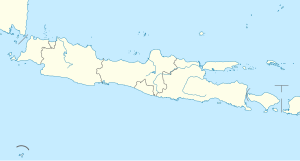Pagerungan Besar
| Pagerungan Besar | ||
|---|---|---|
| Waters | Bali Sea | |
| Archipelago | Kangean Islands | |
| Geographical location | 6 ° 57 ′ S , 115 ° 55 ′ E | |
|
|
||
| surface | 355 ha | |
| Residents | 5586 (2010) | |
The island of Pagerungan Besar ( German Groß-Pagerungan ) belongs to the Indonesian Pagerungan Islands and thus to the Kangean Islands .
geography
overview
Pagerungan Besar forms together with Pagerungan Kecil ( German: Klein-Pagerungan ) to the west, the Pagerungan Islands. You are in the northeast of the Kangean Islands. The entire archipelago is located in the Bali Sea , north of the island of Bali and north-east of Java to the Kangeaninseln belong administratively. Pagerungan Besar forms an administrative village (Desa) of the district ( Indonesian Kecamatan ) Sapeken in the administrative district ( Indonesian Kabupaten ) Sumenep of the province of East Java ( Indonesian Jawa Timur ).
Pagerungan Besar covers an area of 355 hectares. In addition to the settlement Mesigit , with its center in the west of the island, there are mangrove swamps, seagrass and coral reefs. Surface waters such as rivers, lakes or water holes are missing. The underwater visibility in the sea is up to twelve meters.
climate
The climate is tropical and is determined by the monsoons . The annual precipitation is 1500 to 2000 mm, the air temperature between 22 and 33 ° C. The water temperature is 26 to 29 ° C.
fauna and Flora
The marine ecosystem is typical of tropical waters. Flat limestone platforms provide the basis for macroalgae and seaweed. The coral reefs are important breeding grounds, living space and food resources for fish. Also green turtles ( Chelonia mydas ), hawksbill turtles ( Eretmochelys imbricata ) and dugongs ( Dugong dugong ) can be found here. Shorebirds also benefit from the shallow reef waters. Some reefs show signs of damage, but mostly they are in good condition.
Residents
5,586 people (2010 census) live in around 800 households on Pagerungan Besar. They are mostly Muslim.
Culturally, Bugis from South Sulawesi and Maduresen from the island of the same name mix here , both groups with a close tradition of fishing.
economy
Eight out of ten residents still make a living from fishing today. Around 1500 tons of fish are caught each year. Commercial catches are mackerel and tuna , snapper , grouper , milk fish ( Chanos chanos ), but also ornamental fish. The other fish are dried and salted because there is no cooling capacity. It was not until the Atlantic Richfield Company (ARCO), a natural gas producer, that an ice machine (5 tons per day) and cold rooms for 20 tons of fish were built. The other inhabitants cultivate arable land for their own use. Corn, cassava, soybeans and fruits are planted. Only coconuts grow so abundantly that they are also exported.
In 1985 natural gas fields were discovered north of Pagerungan Besar, and extraction began in 1994. To the east of Pagerungan Besar is the ARCO industrial area Torohhiga , with a runway and pier . The peak of the funding was between 1998 and 2001 with 350 to 450 mmscfd (Million Standard Cubic Feet per Day). Since then, the quantities extracted have been falling, but the natural gas field remains an important supplier in the region. Pipelines carry the gas to Surabaya . 500 locals found work in the construction of the industrial plants, today a hundred locals still work in the plant.
Facilities
Before natural gas production began, there were only three primary schools and one madrasa (Islamic school) for 650 students. ARCO is now driving the development of the island. A junior high school, three elementary schools and a new madrasa were built. The mosque was also renewed. A community hall, a sports and youth center and new health facilities were newly built.
The supply of electricity and water to the population was also expanded. A reverse osmosis system with a capacity of 150 cubic meters per day is used to obtain drinking water , 30 cubic meters of which are made available to the population, the rest is used by the operators of the industrial plants. In addition, he also built a retention basin for rainwater with a capacity of 1500 cubic meters. This is intended to protect the island's groundwater. Two wastewater treatment plants purify wastewater from the industrial plants. The treated wastewater is drained into deep water layers.
Individual evidence
- ↑ a b Penduduk Indonesia menurut desa 2010 ( Memento from March 27, 2014 in the Internet Archive ) (Indonesian; PDF; 6.0 MB), accessed on January 26, 2013
- ↑ a b Mapcarta: Pulau Pagerungan-besar , accessed on November 15, 2016.
- ↑ a b c d e f g h i j k Ian A. Bowles, Glenn T. Prickett: Footprints in the Jungle: Natural Resource Industries, Infrastructure, and Biodiversity Conservation , pp. 74 ff. , 2001.
- ^ Kangean Energy Indonesia: Pagerungan Field , accessed November 15, 2016.
